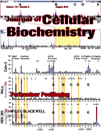
CELL PROLIFERATION
Scope & Guideline
Advancing the Frontiers of Cellular Research
Introduction
Aims and Scopes
- Cancer Biology:
Research on the molecular and cellular mechanisms underlying cancer proliferation, metastasis, and resistance to therapy, including studies on tumor microenvironment interactions and novel therapeutic targets. - Stem Cell Research:
Exploration of stem cell biology, differentiation, and applications in regenerative medicine, including studies on induced pluripotent stem cells and adult progenitor cells. - Cell Signaling Pathways:
Investigations into the various signaling pathways that regulate cell proliferation, apoptosis, and differentiation, including the roles of growth factors, cytokines, and genetic modifications. - Cellular Mechanisms of Disease:
Studies examining the cellular mechanisms behind diseases such as neurodegeneration, cardiovascular diseases, and metabolic disorders, focusing on how alterations in cell function contribute to disease pathology. - Tissue Engineering and Regenerative Medicine:
Research on the development of biomaterials and cellular therapies aimed at repairing or regenerating damaged tissues and organs, including the use of 3D bioprinting and stem cell-derived products.
Trending and Emerging
- Tetrahedral Framework Nucleic Acids and Nanotechnology:
Emerging research on tetrahedral framework nucleic acids (tFNAs) and their applications in drug delivery and gene therapy is gaining momentum, reflecting a broader trend towards nanotechnology in biomedical research. - Single-Cell Sequencing and Personalized Medicine:
The increasing application of single-cell RNA sequencing technologies is enabling deeper insights into cellular heterogeneity in various diseases, particularly in cancer, enhancing the potential for personalized medicine. - Mechanisms of Regulated Cell Death:
Research focused on different forms of regulated cell death such as ferroptosis and pyroptosis is trending, highlighting their roles in cancer therapy and tissue homeostasis. - Microbiome and Immune Interactions:
Studies exploring the interactions between the microbiome, immune system, and their influence on various diseases, particularly in cancer and metabolic disorders, are emerging as a significant area of interest. - Epigenetics and Gene Regulation:
An increasing emphasis on epigenetic modifications and their roles in gene regulation, development, and disease progression reflects a growing recognition of their importance in cell proliferation and differentiation.
Declining or Waning
- Basic Mechanisms of Cell Cycle Regulation:
Research directly focused on the fundamental mechanisms of the cell cycle, while still relevant, has seen a decrease in the number of dedicated studies, potentially overshadowed by more complex interactions in cancer and stem cell contexts. - Traditional Cancer Therapies:
There is a noticeable decline in studies solely centered on traditional cancer therapies (such as chemotherapy) without innovative approaches or combinations, as the field shifts towards personalized and targeted therapies. - In vitro Models of Disease:
While in vitro models remain crucial, the focus has shifted towards more complex systems such as organoids and 3D cultures, leading to a reduction in publications centered on traditional 2D cell culture models.
Similar Journals

Cell Division
Exploring the intricacies of cellular mechanisms.Cell Division, an esteemed journal published by BMC, serves as a critical platform for researchers in the fields of biochemistry, cell biology, and molecular biology, showcasing groundbreaking studies and novel insights in the mechanisms governing cell division. Since its establishment in 2006, this Open Access journal, based in the United Kingdom, has strived to promote rigorous scientific discourse, ensuring unrestricted access to its rich content. With a commendable impact factor reflected in its Q1 and Q2 categorizations across various biological disciplines, Cell Division is recognized for its influence and relevance in the academic community. Targeting professionals, researchers, and students alike, it aims to disseminate high-quality research findings that further our understanding of cellular processes and contribute to advances in medical and biotechnological applications. Engage with leading-edge research and broaden your knowledge base in cell biology through this dynamic publication that continues to evolve through 2024 and beyond.

DNA AND CELL BIOLOGY
Empowering Scientific Progress Through Rigorous ResearchDNA AND CELL BIOLOGY, published by Mary Ann Liebert, Inc, is a distinguished journal in the realms of cell biology, genetics, and molecular biology, holding a notable position in its Q3 and Q2 quartile rankings across multiple academic categories as of 2023. With an ISSN of 1044-5498 and an E-ISSN of 1557-7430, this journal has been a pivotal platform for the dissemination of cutting-edge research since its inception in 1990, extending its coverage through 2024. Situated in the United States, the journal offers high-quality peer-reviewed articles, exploring significant advancements in biological sciences while fostering interdisciplinary collaborations within the research community. Though it currently does not offer open access, subscribed institutions and individual readers benefit from its rich repository of knowledge. The journal's rigorous standards and impactful content make it an essential resource for researchers, professionals, and students alike, aiming to stay at the forefront of discoveries influencing DNA and cellular dynamics.

JOURNAL OF CELLULAR BIOCHEMISTRY
Exploring the Intricacies of Cellular ProcessesJournal of Cellular Biochemistry is a premier academic journal dedicated to advancing the field of biochemistry and cellular biology. Published by Wiley, this influential journal has a significant impact factor that underscores its relevance and authority within the scientific community. With its ISSN 0730-2312 and E-ISSN 1097-4644, the journal has been on the frontier of research since its inception in 1982, and is expected to continue publishing cutting-edge studies through 2024. As evidenced by its ranking in the 2023 Scopus Quartiles, it holds a rank of Q2 in Biochemistry and Q3 in both Cell and Molecular Biology, placing it among the top tiers of scientific journals in these disciplines. The Journal of Cellular Biochemistry serves as a vital resource for researchers, professionals, and students alike, providing a platform for the dissemination of innovative ideas and findings that shape our understanding of cellular processes and biochemical pathways. Though it does not currently offer Open Access options, its robust peer-review process ensures that each publication meets the highest academic standards, thus solidifying its esteemed position in the landscape of biochemical research.

STEM CELLS AND DEVELOPMENT
Elevating Knowledge in Stem Cell Biology and DevelopmentSTEM CELLS AND DEVELOPMENT, published by Mary Ann Liebert, Inc., is a leading peer-reviewed journal dedicated to the rapidly advancing fields of stem cell biology and developmental science. With an ISSN of 1547-3287 and an E-ISSN of 1557-8534, the journal encompasses a broad range of topics central to understanding stem cells' roles in development and regeneration processes. It holds a prestigious standing within its category quartiles, ranking Q3 in Cell Biology, Q2 in Developmental Biology, and Q2 in Hematology for 2023. With its convergence from 2004 to 2024, STEM CELLS AND DEVELOPMENT fosters an innovative platform for researchers, professionals, and students to disseminate groundbreaking research, share insights, and explore novel therapeutic approaches. Open access options enhance the journal's visibility and accessibility, promoting a collaborative exchange of information among the scientific community. Positioned at the forefront of stem cell research and its applications, this journal is vital for anyone seeking to stay informed about the latest advancements and trends within these critical areas of study.

Cell Stem Cell
Elevating Research Standards in Stem Cell and Molecular BiologyCell Stem Cell, published by CELL PRESS, is a premier journal at the forefront of cellular biology, genetics, and molecular medicine. With an esteemed impact factor and recognized as a Q1 journal in multiple categories including Cell Biology, Genetics, and Molecular Medicine, it offers researchers, professionals, and students rigorous, peer-reviewed articles that shape the future of stem cell research and regenerative medicine. Located in Cambridge, MA, this journal has become an invaluable resource since its inception in 2007 and is committed to disseminating groundbreaking findings that drive innovation and understanding in these critical fields. By consistently ranking within the top percentile of its categories in Scopus, Cell Stem Cell remains an essential platform for scholarly communication, fostering collaboration among leading scientists worldwide. Although the journal does not currently offer open access options, its comprehensive insights are pivotal for anyone engaged in the study of stem cells and their applications.

BIOCELL
Exploring the Depths of Biochemistry and GeneticsBIOCELL is a distinguished peer-reviewed journal dedicated to the field of Cell Biology, published by TECH SCIENCE PRESS. Since its inception in 1995, the journal has been at the forefront of disseminating innovative research, with converged publication years extending from 1995 to 2013 and from 2015 to 2024. Although it currently holds a Q4 ranking in the Cell Biology category according to the 2023 category quartiles, BIOCELL aims to foster advancements by providing a platform for researchers, professionals, and students to share their findings in biochemistry, genetics, and molecular biology. The journal is available in both print (ISSN: 0327-9545) and digital formats (E-ISSN: 1667-5746) and seeks to attract contributions that enhance scholarly dialogue and understandings of cellular mechanisms and innovations. With a commitment to quality research and critical discourse, BIOCELL plays an important role in nurturing the scientific community within Argentina and beyond, offering vital insights that contribute to the advancement of the life sciences.

CELLULAR & MOLECULAR BIOLOGY LETTERS
Pioneering Research in Biochemistry and Cell BiologyCELLULAR & MOLECULAR BIOLOGY LETTERS, published by BMC, is a premier open-access journal dedicated to disseminating high-quality research in the fields of Biochemistry, Cell Biology, and Molecular Biology. Established in 1996, the journal has emerged as a leader in its domain, boasting an impressive Q1 ranking across three critical categories as of 2023, reflecting its significant impact within the scientific community. With an ISSN of 1425-8153 and an E-ISSN of 1689-1392, it offers accessible research findings to a global audience, having been open access since 2013. Situated in the United Kingdom, at CAMPUS, 4 CRINAN ST, LONDON N1 9XW, the journal continues to serve as a vital resource for researchers, professionals, and students, contributing to advancements in the understanding of cellular and molecular processes. By providing a platform for original research, reviews, and short communications, CELLULAR & MOLECULAR BIOLOGY LETTERS plays a crucial role in fostering dialogue and collaboration within the scientific community.

Stem Cell Research & Therapy
Exploring Breakthroughs in Stem Cell BiologyStem Cell Research & Therapy is an esteemed international journal published by BMC, specializing in the rapidly advancing fields of stem cell research and regenerative therapies. Since its inception in 2010, the journal has embraced an Open Access model, ensuring that vital research is readily accessible to a global audience. With a significant impact in the scientific community, it holds Q1 quartile rankings in prestigious categories such as Biochemistry, Genetics and Molecular Biology, Cell Biology, and Molecular Medicine, highlighting its critical role in promoting groundbreaking research. The journal’s high Scopus rankings—placing it in the top echelons of its fields—reflect its commitment to publishing high-quality, peer-reviewed studies that advance our understanding of stem cell biology and therapeutic applications. Aimed at researchers, healthcare professionals, and students alike, Stem Cell Research & Therapy is an indispensable resource for those dedicated to the exploration and innovation within this transformative area of science.

EXPERIMENTAL CELL RESEARCH
Exploring the Frontiers of Cell BiologyEXPERIMENTAL CELL RESEARCH is a highly respected journal published by Elsevier Inc, specializing in the dynamic and ever-evolving field of Cell Biology. With an impact factor positioned in the Q2 quartile for 2023, it ranks at the 124th position out of 285 in the Scopus Ranks, indicating a solid reputation among peers in the domains of biochemistry, genetics, and molecular biology. Since its inception in 1950, the journal has contributed significantly to the dissemination of groundbreaking research, providing a platform for studies that explore the nuances of cellular mechanisms, processes, and experimental methodologies. Although the journal currently does not offer open access, its commitment to high-quality, peer-reviewed research continues to attract submissions from leading scientists and scholars across the globe. Researchers, professionals, and students alike will find this journal an invaluable resource for keeping abreast of current developments and innovative breakthroughs in cellular science.

CELL RESEARCH
Unveiling the Mysteries of Cellular MechanismsCELL RESEARCH is a premier peer-reviewed journal dedicated to advancing the field of cell biology and molecular biology, published by SpringerNature. With an impressive impact factor and consistently ranking in the Q1 quartile for both cell biology and molecular biology, this journal serves as a pivotal resource for researchers, professionals, and students seeking to explore the latest discoveries and advancements in cellular mechanisms and their implications for health and disease. Since its inception in 1996, CELL RESEARCH has cultivated a distinguished reputation, currently boasting ranks in the top percentile of Scopus categories, reaffirming its influence and relevance to the scientific community. Although it is not an Open Access journal, its rigorous selection process ensures the publication of high-quality articles that contribute significantly to our understanding of life sciences. For those deeply engaged in the realms of biochemistry, genetics, and molecular biology, CELL RESEARCH is an essential conduit of innovative research and critical insights.